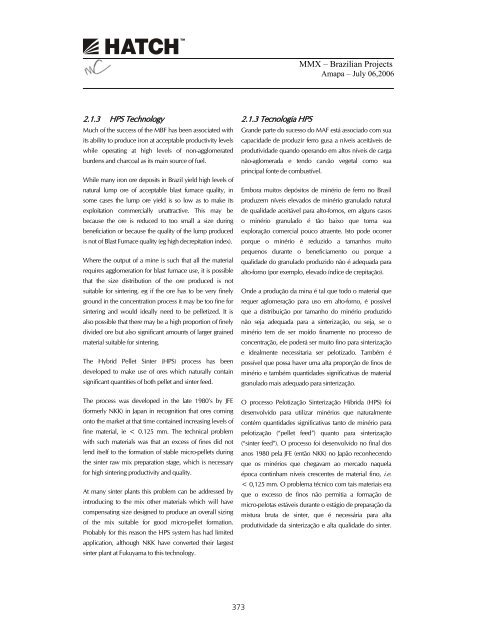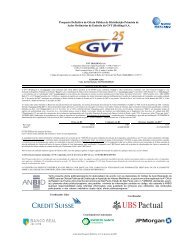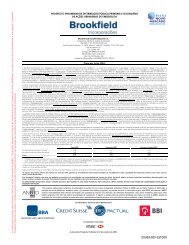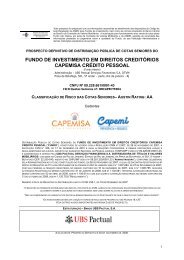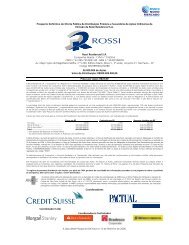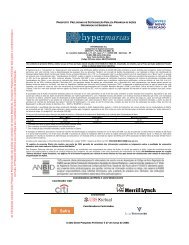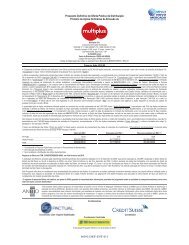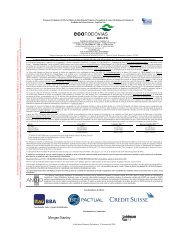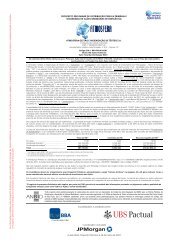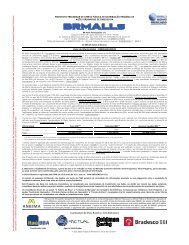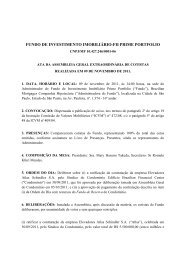- Page 2 and 3:
(Esta página foi intencionalmente
- Page 5 and 6:
1. INTRODUÇÃO• Definições•
- Page 7 and 8:
CADECBLCCDICentennial AssetCETIPCMN
- Page 10 and 11:
Investidores da Oferta deDispersão
- Page 12 and 13:
Pedido de ReservaPeríodo de Coloca
- Page 14 and 15:
GLOSSÁRIO DE TERMOS TÉCNICOSAlto
- Page 16 and 17:
Reservas Comprovadas(mensuradas)Res
- Page 18 and 19:
Sistemas Integrados MMXRecursos Min
- Page 20 and 21:
Situação AtualProjeto de Mineraç
- Page 22 and 23:
Outros Eventos. Em 2 de maio de 200
- Page 24 and 25:
PONTOS FORTESAcreditamos que possui
- Page 26 and 27:
Maximizar a Rentabilidade de Nossas
- Page 28 and 29:
ESTRUTURA SOCIETÁRIANossa estrutur
- Page 30 and 31:
SUMÁRIO DA OFERTACompanhiaAçõesM
- Page 32 and 33:
Coordenador e BookrunnerCoordenador
- Page 34 and 35:
RESUMO DAS DEMONSTRAÇÕES FINANCEI
- Page 36 and 37:
As nossas demonstrações financeir
- Page 38 and 39:
PREÇO POR AÇÃONo contexto da Ofe
- Page 40 and 41:
INADEQUAÇÃO DA OFERTATodos os inv
- Page 42 and 43:
(vii) caso a totalidade dos Pedidos
- Page 44 and 45:
Caso a totalidade das Ações aloca
- Page 46 and 47:
DIREITOS,VANTAGENS E RESTRIÇÕES D
- Page 48 and 49:
Corretoras ConsorciadasInstituiçõ
- Page 50 and 51:
5. Instituição SubcontratadaBanco
- Page 52 and 53:
INFORMAÇÕES CADASTRAIS DA COMPANH
- Page 54 and 55:
PARTICIPAÇÃO NO MERCADO E OUTRAS
- Page 56 and 57:
As palavras “acredita”, “pode
- Page 58 and 59:
Podemos não ser capazes de obter t
- Page 60 and 61:
• da precisão dos índices estim
- Page 62 and 63:
Adicionalmente, tendo por base noss
- Page 64 and 65:
A perda de membros chave da adminis
- Page 66 and 67:
Caso qualquer um desses riscos e pe
- Page 68 and 69:
• a obtenção de licenças ambie
- Page 70 and 71:
Anti-dumping, direitos compensatór
- Page 72 and 73:
As flutuações nas taxas de juros
- Page 74 and 75:
As vendas substanciais reais ou est
- Page 76 and 77:
Sistema MMX AmapáProjeto de Minera
- Page 78 and 79:
2. INFORMAÇÕES SOBRE A COMPANHIA
- Page 80 and 81:
DILUIÇÃOEm 31 de março de 2006,
- Page 82 and 83:
Demonstrações de Resultado:Perío
- Page 84 and 85:
Atualmente, por meio de uma concess
- Page 86 and 87:
AMBIENTE ECONÔMICO BRASILEIROComo
- Page 88 and 89:
PreçosAs exportações do minério
- Page 90 and 91:
11. Em 14 de julho de 2006, a MMX A
- Page 92 and 93:
Além disso, ocasionalmente, a Comp
- Page 94 and 95:
Atividade de Investimento/Desinvest
- Page 96 and 97:
Obrigações decorrentes de aquisi
- Page 98 and 99:
RESUMO DOS ESTUDOS DE VIABILIDADE E
- Page 100 and 101:
Sistema MMX AmapáCapex TotalUS$ x
- Page 102 and 103:
Sistema MMX AmapáMina e Beneficiam
- Page 104 and 105:
Após a assinatura dos contratos de
- Page 106 and 107:
O Sistema MMX Corumbá baseia-se na
- Page 108 and 109:
O investimento estimado para os doi
- Page 110 and 111:
Os preços médios históricos de m
- Page 112 and 113:
Cronograma de Investimentos (US$ (m
- Page 114 and 115:
O custo operacional dos MAFs está
- Page 116 and 117:
O custo médio de transformação d
- Page 118 and 119:
Ao longo de 2006 e início de 2007
- Page 120 and 121:
Esta planta de pelotização fará
- Page 122 and 123:
VISÃO GERAL DO SETORSETOR DE MINÉ
- Page 124 and 125:
• A CVRD também planeja aumentar
- Page 126 and 127:
Os preços de exportação do ferro
- Page 128 and 129:
1995 2000 2003 2004 2005(porcentage
- Page 130 and 131:
ATIVIDADES DA COMPANHIAVISÃO GERAL
- Page 132 and 133:
PONTOS FORTESAcreditamos que possui
- Page 134 and 135:
Maximizar a Rentabilidade de Nossas
- Page 136 and 137:
Nossa estrutura societária na data
- Page 138 and 139:
• Obter Alvará de Autorização
- Page 140 and 141:
Acreditamos que a Mina Corumbá, ao
- Page 142 and 143:
FinanciamentosProjeto de Mineraçã
- Page 144 and 145:
Para iniciar a lavra da Mina Amapá
- Page 146 and 147:
FinanciamentosProjeto de Mineraçã
- Page 148 and 149:
Pesquisa Geológica Minas - RioA Co
- Page 150 and 151:
FinanciamentosProjeto de Mineraçã
- Page 152 and 153:
ConcorrênciaO mercado internaciona
- Page 154 and 155:
Aspectos AmbientaisAs legislações
- Page 156 and 157:
A tabela que se segue indica o núm
- Page 158 and 159:
Em 2 de junho de 2006, a MMX Amapá
- Page 160 and 161:
Para obter uma descrição dos cont
- Page 162 and 163:
Apresentamos na tabela abaixo os no
- Page 164 and 165:
O Conselho Fiscal não pode ter mem
- Page 166 and 167:
Aos 14 principais gerentes da Compa
- Page 168 and 169:
OPERAÇÕES COM PARTES RELACIONADAS
- Page 170 and 171:
Regulação do Mercado de Capitais
- Page 172 and 173:
DISPERSÃO ACIONÁRIA EM DISTRIBUI
- Page 174 and 175:
É de responsabilidade do Diretor d
- Page 176 and 177:
Contratos com o mesmo grupoSegundo
- Page 178 and 179:
DIREITOS CONFERIDOS PELAS AÇÕESNo
- Page 180 and 181:
Local da Realização de Assembléi
- Page 182 and 183:
ALOCAÇÃO DO LUCRO LÍQUIDO E DIST
- Page 184 and 185:
Os titulares de ações na data em
- Page 186 and 187:
RESGATEDe acordo com a Lei das Soci
- Page 188 and 189:
ALIENAÇÃO DE CONTROLEDe acordo co
- Page 190 and 191:
A liquidação das operações real
- Page 192 and 193:
SISTEMA MMX CORUMBÁ-MSPROJETO MIN
- Page 194 and 195:
SISTEMA MMX-CORUMBÁ- MSProjeto de
- Page 196 and 197:
SISTEMA MMX-CORUMBÁ- MSProjeto de
- Page 198 and 199:
SISTEMA MMX-CORUMBÁ- MSProjeto de
- Page 200 and 201:
SISTEMA MMX-CORUMBÁ- MSProjeto de
- Page 202 and 203:
SISTEMA MMX-CORUMBÁ- MSProjeto de
- Page 204 and 205:
SISTEMA MMX-CORUMBÁ- MSProjeto de
- Page 206 and 207:
SISTEMA MMX-CORUMBÁ- MSProjeto de
- Page 208 and 209:
SISTEMA MMX-CORUMBÁ- MSProjeto de
- Page 210 and 211:
SISTEMA MMX-CORUMBÁ- MSProjeto de
- Page 212 and 213:
SISTEMA MMX-CORUMBÁ- MSProjeto de
- Page 214 and 215:
SISTEMA MMX-CORUMBÁ- MSProjeto de
- Page 216 and 217:
MMX - Brazilian ProjectsCorumbá Pr
- Page 218 and 219:
MMX - Brazilian ProjectsCorumbá Pr
- Page 220 and 221:
MMX - Brazilian ProjectsCorumbá Pr
- Page 222 and 223:
MMX - Brazilian ProjectsCorumbá Pr
- Page 224 and 225:
MMX - Brazilian ProjectsCorumbá Pr
- Page 226 and 227:
MMX - Brazilian ProjectsCorumbá Pr
- Page 228 and 229:
MMX - Brazilian ProjectsCorumbá Pr
- Page 230 and 231:
MMX - Brazilian ProjectsCorumbá Pr
- Page 232 and 233:
MMX - Brazilian ProjectsCorumbá Pr
- Page 234 and 235:
MMX - Brazilian ProjectsCorumbá Pr
- Page 236 and 237:
MMX - Brazilian ProjectsCorumbá Pr
- Page 238 and 239:
MMX - Brazilian ProjectsCorumbá Pr
- Page 240 and 241:
MMX - Brazilian ProjectsCorumbá Pr
- Page 242 and 243:
MMX - Brazilian ProjectsCorumbá Pr
- Page 244 and 245:
MMX - Brazilian ProjectsCorumbá Pr
- Page 246 and 247:
MMX - Brazilian ProjectsCorumbá Pr
- Page 248 and 249:
MMX - Brazilian ProjectsCorumbá Pr
- Page 250 and 251:
MMX - Brazilian ProjectsCorumbá Pr
- Page 252 and 253:
MMX - Brazilian ProjectsCorumbá Pr
- Page 254 and 255:
MMX - Brazilian ProjectsCorumbá Pr
- Page 256 and 257:
MMX - Brazilian ProjectsCorumbá Pr
- Page 258 and 259:
MMX - Brazilian ProjectsCorumbá Pr
- Page 260 and 261:
MMX - Brazilian ProjectsCorumbá Pr
- Page 262 and 263:
MMX - Brazilian ProjectsCorumbá Pr
- Page 264 and 265:
MMX - Brazilian ProjectsCorumbá Pr
- Page 266 and 267:
MMX - Brazilian ProjectsCorumbá Pr
- Page 268 and 269:
MMX - Brazilian ProjectsCorumbá Pr
- Page 270 and 271:
MMX - Brazilian ProjectsCorumbá Pr
- Page 272 and 273:
MMX - Brazilian ProjectsCorumbá Pr
- Page 274 and 275:
MMX - Brazilian ProjectsCorumbá Pr
- Page 276 and 277:
MMX - Brazilian ProjectsCorumbá Pr
- Page 278 and 279:
MMX - Brazilian ProjectsCorumbá Pr
- Page 280 and 281:
MMX - Brazilian ProjectsCorumbá Pr
- Page 282 and 283:
MMX - Brazilian ProjectsCorumbá Pr
- Page 284 and 285:
MMX - Brazilian ProjectsCorumbá Pr
- Page 286 and 287:
MMX - Brazilian ProjectsCorumbá Pr
- Page 288 and 289:
MMX - Brazilian ProjectsCorumbá Pr
- Page 290 and 291:
MMX - Brazilian ProjectsCorumbá Pr
- Page 292 and 293:
MMX - Brazilian ProjectsCorumbá Pr
- Page 294 and 295:
MMX - Brazilian ProjectsCorumbá Pr
- Page 296 and 297:
MMX - Brazilian ProjectsCorumbá Pr
- Page 298 and 299:
MMX - Brazilian ProjectsCorumbá Pr
- Page 300 and 301:
MMX - Brazilian ProjectsCorumbá Pr
- Page 302 and 303:
MMX - Brazilian ProjectsCorumbá Pr
- Page 304 and 305:
MMX - Brazilian ProjectsCorumbá Pr
- Page 306 and 307:
MMX - Brazilian ProjectsCorumbá Pr
- Page 308 and 309:
MMX - Brazilian ProjectsCorumbá Pr
- Page 310 and 311:
MMX - Brazilian ProjectsCorumbá Pr
- Page 312 and 313:
MMX - Brazilian ProjectsCorumbá Pr
- Page 314 and 315:
MMX - Brazilian ProjectsCorumbá Pr
- Page 316 and 317:
MMX - Brazilian ProjectsCorumbá Pr
- Page 318 and 319:
MMX - Brazilian ProjectsCorumbá Pr
- Page 320 and 321:
MMX - Brazilian ProjectsCorumbá Pr
- Page 322 and 323:
MMX - Brazilian ProjectsCorumbá Pr
- Page 324 and 325:
MMX - Brazilian ProjectsCorumbá Pr
- Page 326 and 327: MMX - Brazilian ProjectsCorumbá Pr
- Page 328 and 329: MMX - Brazilian ProjectsCorumbá Pr
- Page 330 and 331: MMX - Brazilian ProjectsCorumbá Pr
- Page 332 and 333: MMX - Brazilian ProjectsCorumbá Pr
- Page 334 and 335: MMX - Brazilian ProjectsCorumbá Pr
- Page 336 and 337: MMX - Brazilian ProjectsCorumbá Pr
- Page 338 and 339: MMX - Brazilian ProjectsCorumbá Pr
- Page 340 and 341: MMX - Brazilian ProjectsCorumbá Pr
- Page 342 and 343: SISTEMA MMX AMAPÁProjeto Amapari d
- Page 344 and 345: SISTEMA MMX AMAPÁProjeto Amapari d
- Page 346 and 347: SISTEMA MMX AMAPÁProjeto Amapari d
- Page 348 and 349: SISTEMA MMX AMAPÁProjeto Amapari d
- Page 350 and 351: SISTEMA MMX AMAPÁProjeto Amapari d
- Page 352 and 353: SISTEMA MMX AMAPÁProjeto Amapari d
- Page 354 and 355: SISTEMA MMX AMAPÁProjeto Amapari d
- Page 356 and 357: SISTEMA MMX AMAPÁProjeto Amapari d
- Page 358 and 359: SISTEMA MMX AMAPÁProjeto Amapari d
- Page 360 and 361: SISTEMA MMX AMAPÁProjeto Amapari d
- Page 362 and 363: MMX - Brazilian ProjectsAmapa - Jul
- Page 364 and 365: MMX - Brazilian ProjectsAmapa - Jul
- Page 366 and 367: MMX - Brazilian ProjectsAmapa - Jul
- Page 368 and 369: MMX - Brazilian ProjectsAmapa - Jul
- Page 370 and 371: MMX - Brazilian ProjectsAmapa - Jul
- Page 372 and 373: MMX - Brazilian ProjectsAmapa - Jul
- Page 374 and 375: MMX - Brazilian ProjectsAmapa - Jul
- Page 378 and 379: MMX - Brazilian ProjectsAmapa - Jul
- Page 380 and 381: MMX - Brazilian ProjectsAmapa - Jul
- Page 382 and 383: MMX - Brazilian ProjectsAmapa - Jul
- Page 384 and 385: MMX - Brazilian ProjectsAmapa - Jul
- Page 386 and 387: MMX - Brazilian ProjectsAmapa - Jul
- Page 388 and 389: MMX - Brazilian ProjectsAmapa - Jul
- Page 390 and 391: MMX - Brazilian ProjectsAmapa - Jul
- Page 392 and 393: MMX - Brazilian ProjectsAmapa - Jul
- Page 394 and 395: MMX - Brazilian ProjectsAmapa - Jul
- Page 396 and 397: MMX - Brazilian ProjectsAmapa - Jul
- Page 398 and 399: MMX - Brazilian ProjectsAmapa - Jul
- Page 400 and 401: MMX - Brazilian ProjectsAmapa - Jul
- Page 402 and 403: MMX - Brazilian ProjectsAmapa - Jul
- Page 404 and 405: MMX - Brazilian ProjectsAmapa - Jul
- Page 406 and 407: MMX - Brazilian ProjectsAmapa - Jul
- Page 408 and 409: MMX - Brazilian ProjectsAmapa - Jul
- Page 410 and 411: MMX - Brazilian ProjectsAmapa - Jul
- Page 412 and 413: MMX - Brazilian ProjectsAmapa - Jul
- Page 414 and 415: MMX - Brazilian ProjectsAmapa - Jul
- Page 416 and 417: MMX - Brazilian ProjectsAmapa - Jul
- Page 418 and 419: MMX - Brazilian ProjectsAmapa - Jul
- Page 420 and 421: MMX - Brazilian ProjectsAmapa - Jul
- Page 422 and 423: MMX - Brazilian ProjectsAmapa - Jul
- Page 424 and 425: MMX - Brazilian ProjectsAmapa - Jul
- Page 426 and 427:
MMX - Brazilian ProjectsAmapa - Jul
- Page 428 and 429:
MMX - Brazilian ProjectsAmapa - Jul
- Page 430 and 431:
MMX - Brazilian ProjectsAmapa - Jul
- Page 432 and 433:
Projeto MMX Minas-RioEstudo de Viab
- Page 434 and 435:
MMXProjeto Minas-RioiiEstudo de Via
- Page 436 and 437:
MMX 1-2Projeto Minas-RioEstudo de V
- Page 438 and 439:
MMX 3-2Projeto Minas-RioEstudo de V
- Page 440 and 441:
MMX 3-4Projeto Minas-RioEstudo de V
- Page 442 and 443:
MMX 3-6Projeto Minas-RioEstudo de V
- Page 444 and 445:
MMX 3-1Projeto Minas-RioEstudo de V
- Page 446 and 447:
MMX 3-3Projeto Minas-RioEstudo de V
- Page 448 and 449:
MMX 3-5Projeto Minas-RioEstudo de V
- Page 450 and 451:
MMX 3-7Projeto Minas-RioEstudo de V
- Page 452 and 453:
MMX 3-9Projeto Minas-RioEstudo de V
- Page 454 and 455:
MMX 3-1Projeto Minas-RioEstudo de V
- Page 456 and 457:
MMX 3-3Projeto Minas-RioEstudo de V
- Page 458 and 459:
MMX 3-1Projeto Minas-RioEstudo de V
- Page 460 and 461:
MMX 3-1Projeto Minas-RioEstudo de V
- Page 462 and 463:
MMX Mineração & Metallicos S.A.Pr
- Page 464 and 465:
MMX Mineração & Metallicos S.A.Pr
- Page 466 and 467:
MMX Mineração & Metallicos S.A.Pr
- Page 468 and 469:
Mineração & Metallicos S.A.Projet
- Page 470 and 471:
Mineração & Metallicos S.A.Projet
- Page 472 and 473:
Mineração & Metallicos S.A.Projet
- Page 474 and 475:
470
- Page 476 and 477:
472
- Page 478 and 479:
CAPÍTULO IIDo Capital Social e das
- Page 480 and 481:
Parágrafo 2º - Dentre os membros
- Page 482 and 483:
(x)(xi)(xii)(xiii)(xiv)(xv)(xvi)del
- Page 484 and 485:
Parágrafo Único -A Companhia ser
- Page 486 and 487:
Artigo 24 - A Assembléia Geral ser
- Page 488 and 489:
CAPÍTULO VIIDa Alienação de Cont
- Page 490 and 491:
Parágrafo 1º - A escolha da empre
- Page 492 and 493:
488
- Page 494 and 495:
490
- Page 496 and 497:
492
- Page 498 and 499:
494
- Page 500 and 501:
496
- Page 502 and 503:
498
- Page 504 and 505:
500
- Page 506 and 507:
502
- Page 508 and 509:
504
- Page 510 and 511:
506
- Page 512 and 513:
508
- Page 514 and 515:
MMX Mineração e Metálicos S.A.(A
- Page 516 and 517:
KPMG Auditores IndependentesAv. Alm
- Page 518 and 519:
MMX Mineração e Metálicos S.A.(A
- Page 520 and 521:
MMX Mineração e Metálicos S.A.(A
- Page 522 and 523:
MMX Mineração e Metálicos S.A.(A
- Page 524 and 525:
MMX Mineração e Metálicos S.A.(A
- Page 526 and 527:
MMX Mineração e Metálicos S.A.(A
- Page 528 and 529:
MMX Mineração e Metálicos S.A.(A
- Page 530 and 531:
MMX Mineração e Metálicos S.A.(A
- Page 532 and 533:
MMX Mineração e Metálicos S.A.(A
- Page 534 and 535:
MMX Mineração e Metálicos S.A.(A
- Page 536 and 537:
MMX Mineração e Metálicos S.A.(A
- Page 538 and 539:
MMX Mineração e Metálicos S.A.(A
- Page 540 and 541:
MMX Mineração e Metálicos S.A.(A
- Page 542 and 543:
MMX Mineração e Metálicos S.A.(A
- Page 544 and 545:
MMX Mineração e Metálicos S.A.(A
- Page 546 and 547:
MMX Mineração e Metálicos S.A.(A
- Page 548 and 549:
MMX Mineração e Metálicos S.A.(A
- Page 550 and 551:
5. Conforme comentado na Nota Expli
- Page 552 and 553:
MMX Mineração e Metálicos S.A.(A
- Page 554 and 555:
MMX Mineração e Metálicos S.A.(A
- Page 556 and 557:
MMX Mineração e Metálicos S.A.(A
- Page 558 and 559:
MMX Mineração e Metálicos S.A.(A
- Page 560 and 561:
MMX Mineração e Metálicos S.A.(A
- Page 562 and 563:
MMX Mineração e Metálicos S.A.(A
- Page 564 and 565:
MMX Mineração e Metálicos S.A.(A
- Page 566 and 567:
MMX Mineração e Metálicos S.A.(A
- Page 568 and 569:
MMX Mineração e Metálicos S.A.(A
- Page 570 and 571:
MMX Mineração e Metálicos S.A.(A
- Page 572 and 573:
MMX Mineração e Metálicos S.A.(A
- Page 574 and 575:
MMX Mineração e Metálicos S.A.(A
- Page 576 and 577:
MMX Mineração e Metálicos S.A.(A
- Page 578 and 579:
MMX Mineração e Metálicos S.A.(A
- Page 580 and 581:
MMX Mineração e Metálicos S.A.(A
- Page 582 and 583:
MMX Mineração e Metálicos S.A.(A
- Page 584 and 585:
MMX Mineração e Metálicos S.A.(A
- Page 586 and 587:
MMX Mineração e Metálicos S.A.(A
- Page 588 and 589:
MMX Mineração e Metálicos S.A. e
- Page 590 and 591:
KPMG Auditores IndependentesAv. Alm
- Page 592 and 593:
MMX Mineração e Metálicos S.A. e
- Page 594 and 595:
MMX Mineração e Metálicos S.A. e
- Page 596 and 597:
MMX Mineração e Metálicos S.A. e
- Page 598 and 599:
MMX Mineração e Metálicos S.A. e
- Page 600 and 601:
MMX Mineração e Metálicos S.A. e
- Page 602 and 603:
MMX Mineração e Metálicos S.A. e
- Page 604 and 605:
MMX Mineração e Metálicos S.A. e
- Page 606 and 607:
MMX Mineração e Metálicos S.A. e
- Page 608 and 609:
MMX Mineração e Metálicos S.A. e
- Page 610 and 611:
MMX Mineração e Metálicos S.A. e
- Page 612 and 613:
MMX Mineração e Metálicos S.A. e
- Page 614 and 615:
MMX Mineração e Metálicos S.A. e
- Page 616 and 617:
MMX Mineração e Metálicos S.A. e
- Page 618 and 619:
MMX Mineração e Metálicos S.A. e
- Page 620 and 621:
MMX Mineração e Metálicos S.A. e
- Page 622 and 623:
MMX Mineração e Metálicos S.A. e
- Page 624 and 625:
MMX Mineração e Metálicos S.A. e
- Page 626 and 627:
MMX Mineração e Metálicos S.A. e
- Page 628 and 629:
MMX Mineração e Metálicos S.A. e
- Page 630 and 631:
MMX Mineração e Metálicos S.A. e
- Page 632 and 633:
MMX Mineração e Metálicos S.A. e
- Page 634:
(Esta página foi intencionalmente


